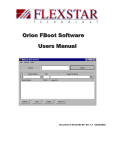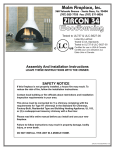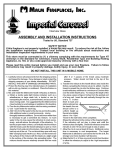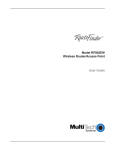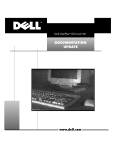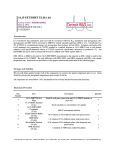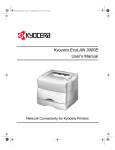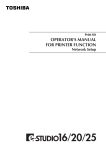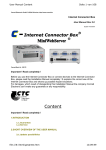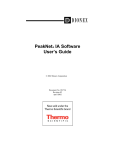Download EcoLAN 1000E - KYOCERA Document Solutions
Transcript
R EcoLAN 1000E Quick Configuration Guide Network Connectivity for the DP-2800 Printer Always read this Quick Configuration Guide thourghly before use. After reading, maintain it in good condition and keep it together with the Quick Configuration Guide for your Laser Printer. FCC Notice: This equipment complies with Part 15 of FCC Rules. Operation is subject to the following two conditions: (1) this device may not cause harmful interference, and (2) this device must accept any interference received, including interference that may cause undesired operation. Introduction The EcoLAN 1000E is an internal network interface card designed specifically for the DP-2800 printer. The EcoLAN 1000E features include: ❒ 10 Mbps Ethernet Interface ❒ 10BaseT / 10Base2 Auto Detection ❒ Multiple Protocol Support ❒ HTTP Server for Management with a Browser ❒ SNMP Support ❒ RS-232 Serial RJ-45 Connector ❒ Flash Upgrade Capability The EcoLAN 1000E enables DP-2800 printer to communicate over an Ethernet network with many different network operating systems, including NetWare, Macintosh, UNIX, and Windows. This Guide’s Role This Quick Configuration Guide provides concise software configuration instructions allowing an experienced system administrator to get the 1000E up and running quickly. For more complete instructions or for printing or configuration options not covered in this guide, please refer to the 1000E Instruction Handbook. 1000E Hardware Installation This guide does not include instructions for installing the 1000E into the printer. Please refer to the 1000E Instruction Handbook for installation instructions for the appropriate printer model. Backwards Compatibility The EcoLAN 1000E is compatible with DP-2800 printer. Thank You Thank you for choosing the award winning Mita network printing products. We are sure you will appreciate the high performance and low cost of ownership that are the hallmarks of Mita products. Always read the Quick Configuration Guide thourghly before use. After reading, maintain it in good condition and keep it together with the Quick Configuration Guide for your Laser Printer. Refer to the Quick Configuration Guide for your Laser Printer for information on the service representative for this product. To ensure safe and correct usage, be sure to read the cautions on safety described in the Instruction Handbook of the Laser Printer before using the machine. Please contact your service representative to order a replacement if the safety warnings in the handbook are illegable or if the handbook itself is missing. (fee required) Trademarks Kyocera® is a registered trademark of Kyocera Corporation. NetWare® is a registered trademark of Novell, Incorporated. Windows® is a registered trademark of Microsoft Corporation. Macintosh® is a registered trademark of Apple Computer, Incorporated. All other products referenced are trademarks or registered trademarks of their respective companies. Contents NetWare 4.x Directory Services Configuration ................ 1 NetWare 2.x & 3.x Configuration ....................................... 5 Windows 95 Peer to Peer Printing Configuration............ 7 Windows NT Configuration ............................................... 9 Macintosh Configuration ................................................. 12 UNIX Configuration .......................................................... 13 NetWare 4.x Directory Services Configuration Bindery vs. NDS Setup In addition to its native NDS (NetWare Directory Services), NetWare 4.x can also be used in Bindery emulation. Bindery emulation is provided on the 1000E for users more familiar with the NetWare Bindery than with NDS. If Bindery emulation is preferred, please refer to the NetWare section of the 1000E Instruction Handbook. PCONSOLE vs. NWADMIN Setup NetWare 4.x setup can be done with either PCONSOLE or NWADMIN. This Quick Configuration Guide includes the procedures in PCONSOLE because fewer steps are required than with NWADMIN. If setup with NWADMIN is preferred, please refer to the NetWare section of the 1000E Instruction Handbook. Configuration Utilities This configuration is accomplished using two utilities, NetWare’s PCONSOLE, and the Windows-based Management Access Program (MAP) included with the 1000E. PCONSOLE Configuration 1. Enter PCONSOLE. 2. Set the Current “Context”. Context is the NetWare term for a specific location in the Directory Services tree. The current context is displayed in the upper left hand corner of the screen. This is where the Print Server, Printer, and Queue will be located. If this is not the desired context for these objects, use the following procedure to change the current context. ➪ Select Change Context from the PCONSOLE main menu. ➪ Press INSERT to browse to the desired context. ➪ Highlight the desired context and press F10. Once in the desired context, make a note of it as displayed in the upper left hand corner of the screen. This context will need to be entered during the configuration with the Management Access Program. Print Server Context: _______________________________ 1 3. Define the Print Server, Printer, and Queue. ➪ Select Quick Setup to display the Print Services Quick Setup screen. Note: If you do not have sufficient rights to create objects in this context, Quick Setup will not appear on the menu. You must have the Object Create right in order to add Print Services. ➪ NetWare inserts a default name or existing Print Server name in the Print Server field. Press ENTER and then INSERT to define the new Print Server. Do not use any spaces in the Print Server name. Make a note of the new Print Server name as it must be duplicated exactly during setup with the Management Access Program. Print Server Name: ________________________________ ➪ Press ENTER at the New Printer and New Print Queue fields to define desired names for these objects. ➪ Move to the Print Queue Volume field and press ENTER. Press INSERT and browse to the desired volume to use for this print queue. ➪ Move to the Printer Type field and press ENTER. Select Other/Unknown from the list. ➪ Press F10 to save this configuration and return to the PCONSOLE main menu. 4. Optional: Assign queue users, select printer notification options, and/or define a Print Server password. If a Print Server password is defined, make a note of it as it must be duplicated exactly during setup with the Management Access Program. Print Server Password: ________________________________ 5. Exit PCONSOLE. MAP Configuration 1. Install and Run the Management Access Program (MAP). MAP is a Windows program for configuration of the EcoLAN 1000E. MAP is on the diskette labelled PC Diskette which is included with the 1000E. Follow the instructions on the diskette label to install the program onto your system. Once installed, double click on the MAP icon to start the program. 2. Select the EcoLAN 1000E to Configure. ➪ Click on the arrow next to the Server dialog for the list of available 1000E units displayed by unit serial number. To display the name and other details of the 1000E units, select Show All from the Options menu. ➪ Click on the 1000E to be configured. 2 3. Password Protection. Many of the configuration options in the MAP utility are password protected. The default password is: sysadm The password is case sensitive. To change the password, select Change Password in the System column. 4. NetWare Configuration. ➪ Select Setup NetWare in the Protocols column. ➪ Enter the Print Server Name, Preferred NDS Context, and Print Server Password (if a password was defined) exactly as they were entered in PCONSOLE. Note: Entries in MAP are not case sensitive (except the sysadm password). Preferred File Server and Preferred NDS Tree should normally remain blank unless Bindery mode is used or if the network includes multiple NDS trees. ➪ If not using Bindery emulation, click the Disable Bindery box. ➪ Type the sysadm password in the appropriate box and click Accept Settings. After a few seconds the screen should report that the update was successful. Click the Back Arrow icon twice to return to the 1000E Configuration page. ➪ Optional: Click on Configure Status Page in the Printer column to define powerup status page settings, (e.g. disabling the powerup status page). ➪ The changes made to the 1000E do not take effect until the unit is reset. Click on Reset in the System column and click on the Reset Unit button. After a few seconds the screen should report that the unit was reset. 5. Confirm Successful Configuration. ➪ After the Reset, the program advises waiting 2 minutes before reconnecting, but the 1000E may be available sooner. From the Options menu, select Update Server List and click the Down Arrow to display the list of Servers. Repeat if necessary until the 1000E reappears and select it from the list. ➪ At the 1000E Configuration page, select Unit Status in the System column. ➪ Scroll down to display the NetWare status. The Queue Status should be Attached. ➪ If the Queue Status is not Attached, please verify that the entries for Print Server Name, Preferred NDS Context, and Print Server Password match those defined in PCONSOLE or refer to the troubleshooting section in the Instruction Handbook. 3 NetWare 2.x & 3.x Configuration 1. Login as Supervisor and start PCONSOLE. 2. Define the Print Queue. ➪ If a Print Queue already exists which will be assigned to the 1000E, skip to step 3. ➪ Select Print Queue Information from the Available Options menu. ➪ Press INSERT, type a name for the new queue to be serviced by the 1000E and press ENTER. Press ESCAPE to return to the Available Options menu. 3. Define the Print Server. ➪ Select Print Server Information from the Available Options menu. ➪ Press INSERT, type the 1000E Print Server name and press ENTER. The default Print Server name is KYO followed by an underscore and the 1000E six digit serial number, e.g. KYO_163709. The serial number is listed on the bottom of the 1000E and is displayed on the 1000E box. If the 1000E has already been installed, the Novell Print Server Name can be found on the powerup network status page under Novell Network Information. 4. Define the Printer. ➪ Press ENTER with the new Print Server highlighted, select Print Server Configuration, then select Printer Configuration. ➪ Select Printer 0 and define a more meaningful name for the printer if desired. The printer name is displayed in various NetWare printing messages, such as when notifying users that their job is completed. ➪ Set the TYPE field to Remote/Other Unknown. ➪ Press ESCAPE to exit and select Yes to save the changes. Press ESCAPE again to return to the Print Server Configuration menu. 5. Assign the Print Queue. ➪ Select Queues Serviced By Printer, highlight the 1000E printer on the Defined Printers list and press ENTER. ➪ Press INSERT to display the Available Queues list. Select the desired queue and assign a Priority level (recommended choice is 1). ➪ Press ESCAPE when finished and continue pressing ESCAPE to exit PCONSOLE. 4 6. Confirm Successful Configuration. ➪ Turn the printer off and on and wait for a powerup network status page to print. If the network is large, the powerup status page may take several minutes to print. (Note: This time may be reduced by setting a Preferred File Server for the 1000E with the Management Access Program. Refer to the NetWare section of the 1000E Instruction Handbook for more information.) ➪ The Novell Connection Information in the bottom half of the status page displays the printer name, file server, queue, etc. If it displays Attached: Yes, this confirms that the 1000E Print Server is ready to accept print jobs. ➪ If the status page does not display Attached: Yes, please verify that the Novell Print Server Name on the status page under Novell Network Information matches exactly with the Print Server name that was entered in PCONSOLE or refer to the troubleshooting section in the Instruction Handbook. 5 Windows 95 Peer to Peer Printing Configuration What is Windows 95 Peer to Peer Printing The peer to peer printing software which is included with the EcoLAN 1000E allows Windows 95 PCs to communicate directly with network attached printers. A network server, such as NetWare or Windows NT, is not required for peer to peer printing. The peer to peer printing software must be installed on each PC that will use peer to peer printing. Once the peer to peer printing software is installed, all EcoLAN 1000E boards on the network automatically appear in the list of available printer ports. The peer to peer printing software can also be used in networks where servers are present, however, often the server print services are utilized instead. Server-based print services offer centralized printing management and spooling and do not require software (other than the printer driver) to be installed on each PC. Optional: Changing the Print Server Name The peer to peer printing software displays the NetWare Print Server Name to identify the 1000E. The default name is the serial number preceded by KYO, e.g., KYO-163495. If desired, this name can be changed to a more easily identifiable name with either the Management Access Program (MAP) or with a standard browser. With the Management Access Program Follow the MAP Configuration instructions in the NetWare 4.x Directory Services Configuration section in this guide (the settings other than NetWare Print Server Name do not need to be entered). The MAP utility requires a NetWare server to be present. With a Browser Connecting to the 1000E with a browser requires the TCP/IP protocol to be loaded on the browser workstation and requires setting an IP address for the 1000E. The 1000E IP address may be set by following the TCP/IP Configuration instructions in the Windows NT Configuration section in this guide. After setting the 1000E IP parameters, connect to the 1000E with the browser by typing, http://<IP address>, e.g. http://192.42.211.5 At the 1000E Home Page, click on 1000E Configuration and follow the MAP Configuration instructions (beginning with step 3) in the NetWare 4.x Directory Services Configuration section in this guide (the settings other than NetWare Print Server Name do not need to be entered). 6 IPX Protocol Installation The IPX protocol is required for peer to peer printing. IPX is not installed by default when Windows 95 is first installed, but it can be easily added using the following procedure. 1. Click on the Windows 95 Start button and select Settings, Control Panel, Network. 2. Check to see if IPX/SPX-compatible Protocol is displayed on the list of network components. If it is on the list, IPX is already installed. Please continue with the next section. If it is NOT on the list, click on Add. 3. Double click on Protocol, click on Microsoft, and double click on IPX/SPXcompatible Protocol. Windows 95 will prompt for the required Windows disks to install the IPX protocol. 4. Once the files are copied, click on OK to close the network control panel. Windows 95 will prompt to restart the system. The IPX protocol will not be active until the system is restarted. Peer to Peer Printing Software Installation 1. Install and Run the Peer to Peer Software. The peer to peer printing software should be installed on each Windows 95 PC that will use peer to peer printing services. The peer to peer printing software is on the diskette labelled Win95 and NT Windows Redirector which is included with the EcoLAN 1000E. Follow the instructions on the diskette label to install the peer to peer printing software onto your system. 2. Select the Printer Port. If the printer driver has not already been installed, please install it from the CD which is shipped with the printer before continuing with the following instructions. ➪ Click on the Windows 95 Start button and select Settings, then Printers. ➪ Right click on the appropriate printer driver and select Properties from the menu. ➪ Select the Details tab and click on the down arrow beside the Print to the following port: field to display the list of available ports. ➪ Select the 1000E from the list of ports and click on OK. The 1000E is displayed by its NetWare Print Server Name, e.g., the default name is in the format KYO-163495. ➪ Peer to peer printing configuration is complete. Print jobs will now be directed to this 1000E when the current printer driver is used. 7 Windows NT Configuration There are several options for setting up printing in a Windows NT environment. ◆ If a NetWare server is present, NetWare print services may be used by following the NetWare configuration instructions in this guide. ◆ Peer to peer print services may be used by following the Windows 95 instructions in this guide, but are only available for Windows NT 4.x, not for Windows NT 3.51. Peer to peer print services use the IPX protocol and may be preferable when TCP/IP setup is not desired. ◆ LPR print services may be used via TCP/IP by following the instructions in this section. Windows NT printing is very flexible. It is possible to configure the individual Windows NT or Windows 95 workstations to print using a different protocol than the Windows NT server. For example, a Windows NT server could be configured to print to a 1000E via TCP/IP using the instructions in this section. The 1000E could then be designated as shared on the NT server, allowing workstations to print via the NT server using a different protocol (such as the default NetBEUI). The optimum Windows NT printing configuration depends upon the particular environment and user and administrator experience and preferences. Generally, the LPR printing over TCP/IP covered in the following instructions is the best choice for environments where TCP/IP is already in use. TCP/IP Required Components The Windows NT system performing the 1000E configuration must have the TCP/IP protocol installed. The following steps describe how to check for and, if necessary, add the required TCP/IP components. Windows NT 3.51 1. In the Program Manager group Main, double click on Control Panel. 2. Double click on Network and check the list of Installed Network Software for the following three components: Microsoft TCP/IP Printing, Simple TCP/IP Services, & TCP/IP Protocol 3. If any of these components are missing, click on Add Software, select TCP/IP Protocol and related components and click on Continue. 4. Select TCP/IP Network Printing Support and Simple TCP/IP Services and click Continue. 5. After all necessary files are copied, click on OK to close the Network Settings dialog and restart the system when prompted. The new protocol and/or services will not be available until the system is restarted. 8 Windows NT 4.0 1. Click on the Windows Start button, select Settings, and Control Panel. 2. Double click on Network and select the Protocols tab. If TCP/IP Protocol is not in the list of Network Protocols, click on Add to install it. 3. Select the Services tab. If either Microsoft TCP/IP Printing or Simple TCP/IP Services is not in the list of Network Services, click on Add to install them. 4. Click on Close when all protocols and services have been added. If the TCP/IP protocol has just been added, Windows will prompt for the IP address and other TCP/IP parameters. The new protocols and services will not be available until the system is restarted. 1000E TCP/IP Configuration A utility called NTBOOTP is used to configure the IP parameters on the 1000E. This utility may be found on the diskette labelled PC Diskette which is included with the 1000E. Note: The NTBOOTP utility does not work when run on a system configured as a DHCP server. 1. In Windows NT 3.51, select Run from the File menu in Program Manager. In Windows NT 4.0, click on the Windows Start button and select Run. 2. Type: A:\NTBOOTP.EXE and click OK to launch the utility. 3. Select Configure from the Admin menu. 4. Enter the IP parameters. ➪ Enter the IP address to assign to the 1000E. ➪ Enter the Subnet mask. If unsure of the correct Subnet mask and the first number in the 1000E IP address is from 192 to 254, then use 255.255.255.0 as the Subnet mask. ➪ Enter the Default Gateway address (the router’s IP address) or leave blank. ➪ Enter the Hardware Address of the 1000E. This address is listed on the powerup network status page under Network Address, for example, 00:40:af:13:c9:f0. Please enter it as it appears on the status page. The status pages (a printer status page and a 1000E status page) may also be printed by pressing the Status key on the front panel of the printer. 5. Click on Go to send the new settings to the 1000E. After a few minutes (usually between 1 and 2 minutes, but possibly up to 5 minutes on very large or busy networks), the 1000E will reset and print its network status page. The new IP parameters will be listed in the TCP/IP Network Information section on the status page. If the status page doesn’t print, recheck the Hardware Address entry in NTBOOTP. (If the powerup status page has been disabled, press the Status key on the printer’s front panel.) Once the status page prints, the new IP address may also be verified by selecting Verify from the Admin menu. 9 Setting Up LPR Printing If the printer driver has not already been installed, please install it from the CD which is shipped with the printer before continuing. In the following instructions, some field or dialog names may be vary depending upon the NT release pack in use. Windows NT 3.51 1. In the Program Manager group Main, open the Control Panel and double click on Printers. 2. Highlight the appropriate printer and select Properties from the Printer menu. 3. Select Other from the list of ports displayed in the Print to: dialog, then select LPR port from the list of Print Destinations. 4. In the Name or address of host providing lpd: field, enter the IP address of the 1000E (that was assigned with NTBOOTP). 5. In the Name of printer or print queue on that server: field, enter any desired port name, e.g. LPR1 and click on OK to return to the Printer Properties dialog. 6. If the printer is to be shared, click on the checkbox next to Share this printer on the network. Click on OK when finished. Windows NT 4.0 1. Click on the Windows 95 Start button and select Settings, and then Printers. 2. Right click on the appropriate printer and select Properties. 3. On the Ports tab, click on Add Port. 4. Double click on LPR Port in the list of available printer ports. 5. In the Name or address of server providing lpd: field, enter the IP address of the 1000E (that was assigned with NTBOOTP). 6. In the Name of printer or print queue on that server: field, enter any desired port name, e.g. LPR1, and click on OK. 7. Click on Close to close the Printer Ports dialog. The 1000E IP address is now displayed and currently selected on the list of ports. 8. If the printer is to be shared, click on the Sharing tab, select Shared and enter the Share name. Click on OK when finished. Selecting a Shared Printer This section briefly describes the steps for accessing a shared printer. Windows 95: In Printer Properties on the Details tab, click the Add Port button and browse the network for the shared printer. Windows NT 3.51: Select Connect to Printer from the Printer menu in Print Manager and choose the shared printer from the shared printers list. Windows NT 4.0: Add a new printer (with Add Printer), select Network Printer Server rather than My Computer and choose the shared printer from the shared printers list. 10 Macintosh Configuration For Macintosh compatibility, Mita printers must be equipped with the KPDL II PostScript option. Installing the Driver and Selecting the Printer 1. To install the Macintosh Printer Driver and Utilities from the CD which is provided with the printer, open the Drivers folder, then the USA/English folder, and double click on the DP-2800 USA Installer. 2. Once installation is complete and your system has been restarted, select Chooser from the Apple menu to open the Chooser. 3. Select the DP-2800 Driver, the zone (if any) and the 1000E printer. The default name for the printer is KYO_ followed by the 1000E six digit serial number. 4. Click on Setup. Select the appropriate PPD file for the printer from the pop-up menu near the bottom of the screen. Turn on Background Printing if desired and close the Chooser. 5. From the File menu within any application, select either Page Setup or Print. 6. Click on the Options button, click on Options Installed, and select the paper handling accessories that are installed on the printer. 7. Optional: Click on the appropriate selection to set the desired defaults for options such as Output Tray, Image Refinement, Duplexing, etc. Naming the Printer and Changing Other Settings There are two methods for changing additional 1000E settings; 1) with the DP-2800 Utility, and 2) with a standard browser. Connecting to the printer’s IP address with a browser allows changing Macintosh, NetWare, and TCP/IP settings on the 1000E, whereas the DP-2800 Utility can only be used to change Macintosh settings on the 1000E. For those users that do not have a browser and/or do not want to assign an IP address to the 1000E, instructions for using the DP-2800 Utility are provided below. Instructions for configuring with a browser can be found in the Instruction Handbook. 1. Double click on the DP-2800 Utility icon on the Macintosh desktop. 2. Highlight KYO_<serial#>, e.g. KYO_163479 in the printer list and click on General. 3. Click on Rename Printer and type the desired printer name in the Printer Name field. Click on OK to return to the General Printer Options dialog. 4. Click on Network Options, select the desired zone for the printer from the Available Zones list and click on Set Zone. 5. Enable or disable the power on status page as desired and click on Done. This completes Macintosh printing configuration. 11 UNIX Configuration UNIX printing utilizes a line printer daemon (lpd) to direct print jobs to the printer. The 1000E supports two modes of lpd printing, host-based lpd and printer-based lpd. With host-based lpd, the line printer daemon is run on one or more workstations (hosts) where print jobs are accepted and sent to the 1000E. With printer-based lpd, the 1000E acts as the line printer daemon host and accepts print jobs directly. Many UNIX systems allow either lpd mode to be used, although configuration may be easier for one of the modes depending upon the UNIX system. Following are some advantages and disadvantages of each mode: Banner Page Comparison The host-based lpd can include the user name and file name on the banner page, while the printer-based lpd can only include the host name. Configuration Comparison The host-based lpd requires configuration on each host that will be sending jobs to the printer, while the printer-based lpd requires only the 1000E to be configured. 1000E Configuration TCP/IP configuration of the 1000E is needed for all versions of UNIX and is therefore covered in this guide. Lpd configuration depends upon the mode selected and the UNIX system in use. Please refer to the Instruction Handbook for lpd configuration instructions for your particular UNIX system. Setting the IP Address The 1000E IP address may be initially set in a variety of ways, including with the MAP utility when a NetWare server is present, with the UNIX bootp daemon, with rarp, or with the standard UNIX command line utility arp. The following instructions use arp, but the other methods may be used instead depending upon user preference. For directions on using one of the other methods, please refer to the Instruction Handbook. 1. Press the Status key on the front panel of the printer with the 1000E, or, if the printer is off, turn it on and wait for the powerup network status page to print. 2. Add an entry to the hosts file (usually etc/hosts) that includes the printer’s name and the IP address. For example, to name the printer ABC7000 and associate it with an IP address of 197.42.211.5, place the following entry in the hosts file: 197.42.211.5 ABC7000 3. At the UNIX command prompt, type: 12 arp -s <desired_IP_address> <1000E_ethernet_address> The 1000E ethernet address is listed on the network status page as Network Address. For example, arp -s 197.42.211.5 00:40:AF:13:A2:70 4. At the UNIX command prompt, type: ping <desired_IP_address> For example, ping 197.42.211.5 The 1000E will not respond to this ping command, but will read the IP address. 5. After a few minutes (usually between 1 and 2 minutes, but possibly up to 5 minutes on very large or busy networks), the 1000E will reset and print its network status page. The new IP address will be listed in the TCP/IP Network Information section. If the status page doesn’t print, recheck the 1000E ethernet address entry in the arp command. Once the status page prints, the new IP address may also be verified with the ping command. Setting Other TCP/IP Parameters Once the IP address is set, the 1000E can be configured via telnet or with a standard web browser. The following steps describe configuration with a standard browser. For instructions on configuring via telnet, refer to the Instruction Handbook. 1. In the browser, connect to http://<1000E_IP_address> For example, http://197.42.211.5 2. At the 1000E’s Home Page, click on 1000E Configuration. 3. Many of the configuration options are password protected. The default password is: sysadm The password is case sensitive. To change the password, select Change Password in the System column. 4. Select Setup TCP/IP in the Protocols column and change the settings as appropriate. If unsure of the correct Subnet mask, and the first number in the 1000E IP address is from 192 to 254, then use 255.255.255.0 as the Subnet mask. The Base Port Number displayed is one less than the printer’s actual port number, thus for the default of 9100, the Base Port Number is set to 9099. Hostbased lpd requires a port number of 10001, therefore, if using host-based lpd, change the Base Port Number to 10000. 5. Type the sysadm password in the appropriate box and click Accept Settings. After a few seconds the screen should report that the update was successful. Click the Back Arrow icon twice to return to the 1000E Configuration page. 6. Optional: Click on Configure Status Page in the Printer column to define powerup status page settings, (e.g. disabling the powerup status page). 7. The changes made to the 1000E do not take effect until the unit is reset. Click on Reset in the System column and click Reset Unit. After a few seconds the screen reports that the unit was reset. TCP/IP configuration is now complete. 13 Published in June ‘98




















